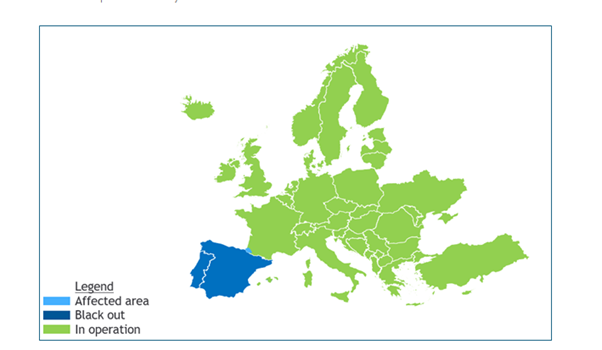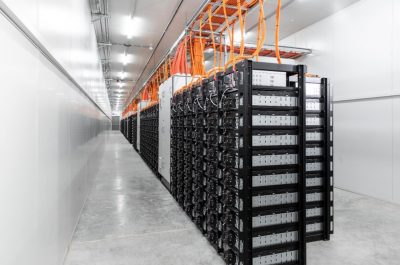Watt happened? Unravelling the Iberian power mystery
The recent major blackout on the Iberian Peninsula received plenty of media attention, with much speculation surrounding what triggered the lights to go out. The European Network of Transmission System Operators (TSOs) for Electricity (ENSTO-E) has formed an expert panel which is now bunkered down to analyse the sequence of events. And no, it wasn’t a monkey this time.
The transmission system operators involved worked swiftly to bring the power system back up within 12-16 hours, indicating the importance of robust, tested restart plans and equipment that will work at any point in the transition.
Could this happen to us in the NEM? Yes, it most certainly could. The grid is not infallible which is why we prepare for the worst but always hope for the best.
Are blackouts becoming more frequent?
The Iberian blackout at the centre of this global attention impacted the Iberian Peninsula – that is, Spain, Portugal, Andorra and parts of Southern France on 28 April 2025. Some 55 million people lost power during a business day.
It is not the only significant blackout recently:
- Chile experienced a near total blackout on 25-26 February 2025, impacting around 80% of its population. A high-voltage transmission line failed with a cascading effect across the power system.
- Sri Lanka also had a major power outage which started around 11.30am on 9 February 2025 which led to the precautionary measure of power rationing for a few days. Whilst a monkey originally got the blame, the Ceylon Electricity Board later confirmed the primary cause was low system stability or low inertia resulting from an exceptionally high contribution from solar PV.
- After three nationwide blackouts in Cuba in late 2024, impacting 9.7 million people, a further blackout occurred on 14 March 2025 after a substation failure.
Reviewing the Iberian event
The European Network of Transmission System Operators (TSOs) for Electricity (ENSTO-E) is an association for cooperation amongst the 40 transmission system operators in Europe across 36 countries. ENSTO-E and its TSO members’ mission is to ensure the security of the interconnected system in all timeframes across pan-European level and the optimal functioning and development of the markets.
As a result of this event, ENSTO-E, its TSO members, the Agency of Cooperations of Energy Regulators (ACER), National Regulatory Authorities and Regional Coordination Centers (RCC) have set up a joint expert panel. The Expert Panel will be led by representatives from Austria and Hungary, with three convenors and 10 experts from TSOs/RCCs so far from across Europe and as far away as Ireland.
In an initial report, the panel will investigate the root cause of the blackout and analyse the events, and then a second report will outline the recommendations to help prevent similar events occurring.
Any information provided, including the below outlined by ENSTO-E is still subject to a more detailed investigation.
What was happening before the blackout?
In the 30 minutes before the event unfolded there were two periods of oscillations, 12.03-12.07 Central European Time (CET) and 12.19-12.21 CET. These power and frequency swings are not unusual in the European grid. The Spanish and French TSOs took actions to mitigate the oscillations. These oscillations shouldn’t have been enough to bring the grid down – something else happened to trigger the cascade of tripping.
During April (shoulder season), it is normal practice to undertake routine maintenance on generation or transmission equipment, so several generating units were offline. It was a sunny day, with a significant penetration of behind-the-meter resources including solar PV, with solar accounting for around 20GW of a system demand of 25GW.
ENSTO-E advised that Spain was exporting just prior to the event: 1GW to France, 2GW to Portugal and 800MW to Morocco.
How the event unfolded
According to early data shared by ENSTO-E, here’s what happened in the crucial 30 seconds[1]:
- Starting at 12.32.57 CET and within the next 20s, a series of generators tripped in southern Spain, resulting in a loss of generation totalling 2.2GW. As a result the frequency dropped and voltage increased in Spain and Portugal.
- Between 12.33.18 and 12.33.21 CET the frequency in the Iberian Peninsula dropped to 48.0Hz and the automatic load shedding plans kicked in.
- At 12.33.21 CET the overhead AC lines between France and Spain protection systems kicked in and they disconnected.
- At 12.33.24 CET, the Iberian system collapsed completely and the HVDC lines between France and Spain disconnected taking the power out in the blue area below and a small area in southern France in light blue was impacted for a short period.

Map of blackout areas, Iberian Peninsula. Image courtesy T&D World
By 12.44 CET, the impacted TSOs were working together to re-energise the grid, re-energising the connections with France and then Morocco, turning on the pumped hydro plants that had black start capability in Spain and the power plants with black start capability in Portugal. Restoration was completed in Portugal by around midnight and in Spain by around 4am. For a grid of this size it was a huge feat to get power restored in Portugal within 12 hours and 16 hours for Spain.
There appear to be some similarities with the 2021 event, continental Europe separation. Failure of 400kV lines in South- East France, overloads and power swings tripped the 4 French-Spain ties, 2.6GW of generation tripped in Spain and 6.4GW load disconnected for under frequency load shedding.
Keeping an eye out for the factual reports and what we can learn?
In a transitioning grid, are there lessons from these events:
- Whilst some of the transmission equipment failures were a result of extreme weather events, could enabling better maintenance windows or managing an earlier repex program have avoided the equipment failure in other events?
- Do we have the right access standards, coordinating the protection settings to be able to ride through these types of events?
- The integrating security framework is moving to improve inertia and system security, in some of these cases would some additional inertia and system strength have avoided the blackout.
- The restart plans need to be robust and the black start plant have the capability when it is needed.
In the National Electricity Market (NEM) we have rule changes on resilience, a security services market for system strength that will start in Decmeber25 and inertia rules that enable forward planning of these services. AEMO has completed the 5 yearly review of the access standards, the rule changes for generation are complete and the rules for load have started consultation, these ensure that connections can ride through a reasonable level of disturbance on the system. The Reliability Panel is reviewing the system restart standards to ensure that the standard remains fit for purpose for the transition. The changes are seeking to implement the needed changes for the transition.
We live life powered by electricity, our phones and computers connect us to work, friends and family and the internet. We rely on electricity for public transport for managing road traffic and getting in/out of multi-story buildings. These events show that electricity supply can change in seconds, so we must be prepared.
[1] https://www.entsoe.eu/news/2025/05/09/entso-e-expert-panel-initiates-the-investigation-into-the-causes-of-iberian-blackout/


